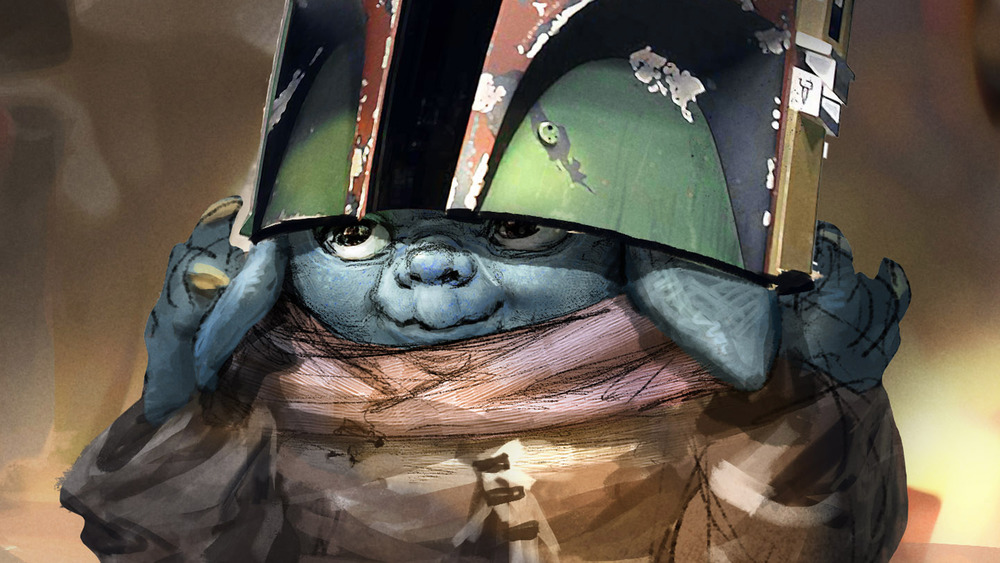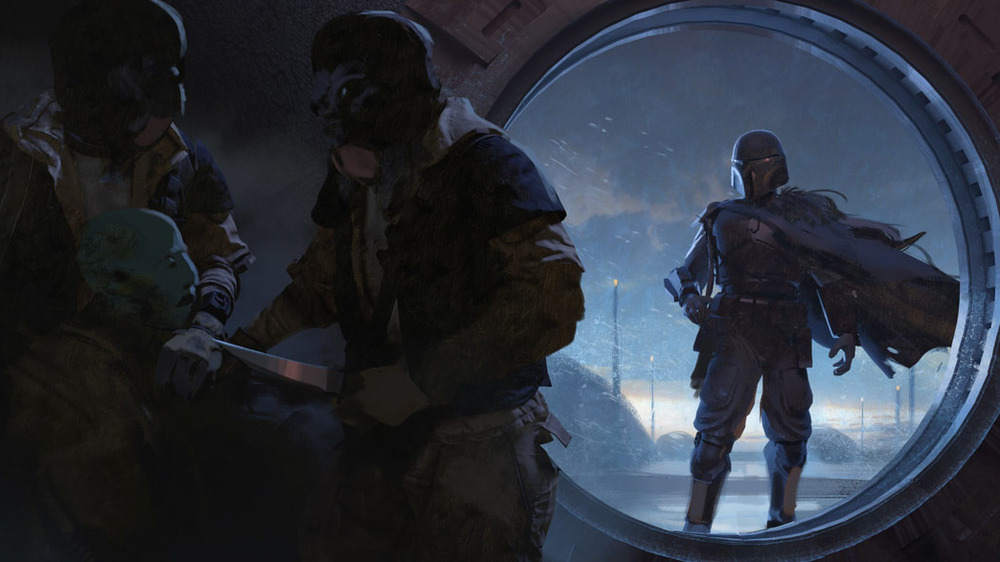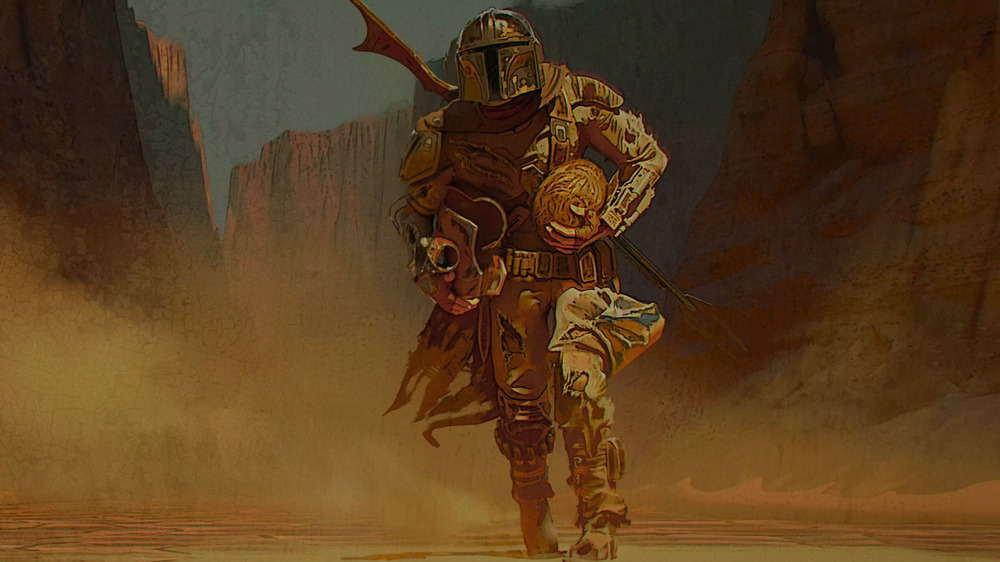Lucasfilm's Phil Szostak Talks The Art Of Star Wars: The Mandalorian - Exclusive Interview
At this point, there's no denying it: The Mandalorian is the most important Star Wars project of the past decade. Just look at all that it's accomplished. First, it proved that live-action Star Wars doesn't just work on the small screen, but thrives. Second, it revolutionized the way television is made, thanks to technical innovations like the large digital set known as "The Volume." It showed firsthand how to make a TV program that appeals to both diehard and casual fans, set the stage for the next wave of Star Wars projects, and made its masked hero and his young charge into legitimate pop culture sensations.
If you want to know how it all started, there's no better place to look than Lucasfilm creative art manager's Phil Szostak's The Art of Star Wars: The Mandalorian (Season One). Despite its title, Szostak's book is much more than just an art collection. Like Szostak's other books, The Art of Star Wars: The Mandalorian pairs concept art with interviews, behind-the-scenes anecdotes, and pieces of trivia. It's basically a visual history of the show's first season, and for fans, it's a must-read.
To commemorate The Art of Star Wars: The Mandalorian's release, Looper conducted an email interview with Szostak just a few days after The Mandalorian's second-season finale. While you won't find anything about Ahsoka Tano, Bo-Katan Kryze, or that one big cameo here — all of that will, presumably, be handled in the next Mandalorian art book — Szostak did take some time to shed light on what it's like making The Mandalorian, and to flesh out some of the ideas introduced in The Art of Star Wars: The Mandalorian. Whether you've read his book yet or not, his answers are absolutely worth a look.
What makes The Mandalorian different from the Star Wars movies, even while honoring their legacy
At this point, you've worked on plenty of movies, but The Mandalorian is your first live-action TV show. From an art perspective, what's the biggest difference between the two?
The Mandalorian is actually my second live-action Star Wars show. I was coordinator of the JAK Films art department at Skywalker Ranch when George Lucas was in early development of another series over a decade ago.
But to answer your question, executive creative director Doug Chiang and the Lucasfilm art department treat The Mandalorian exactly as we would any one of our feature films. The primary difference is the time and budget crunch that comes with designing for television, "a third of the time and half the budget of a typical Star Wars film," as Doug put it in his intro to The Art of Star Wars: The Mandalorian.
Similarly, how does working on The Mandalorian differ from the game projects you've overseen, like Star Wars Battlefront and its sequel, Star Wars: Squadrons, and Jedi: Fallen Order?
My involvement in our Star Wars games projects is fairly minimal, compared to our films and television shows, particularly projects that the Lucasfilm art department are designing full time, like The Mandalorian. But the Lucasfilm Games teams know that they can come to me with any specific questions or legacy photography/concept art reference needs that they have. And they do run their designs by Doug, to make sure they are not straying too far off of the established path or stepping on the toes of a future design or idea they might not yet be aware of.
Brian Matyas and a few of the other artists mention they come from a video game background. Does that change their process at all? What does that perspective add to the production?
"Triple-A" video games are made at such a high, almost photorealistic quality that the design process for them is fairly indistinguishable from that of feature films. So those designers can transition into working on a project like The Mandalorian fairly easily. They are also used to the deadline pressures that come with working in TV.
The Mandalorian takes place in an era of Star Wars we haven't really seen before — post-Return of the Jedi, but years before the sequel trilogy. How did the timeline affect the design of the show?
Doug saw The Mandalorian as an opportunity to finish what he started up with George Lucas at Skywalker Ranch in the mid-'90s, showing the progression of and unifying the design languages of the sequel and original Star Wars trilogies, as elements from both are brought into the series. But for all of our projects, we try to ground our work in the foundational aesthetics of the original Star Wars designers, most notably Ralph McQuarrie, Joe Johnston, and Nilo Rodis-Jamero, and the films, art, and cultures that inspired both them and George Lucas. That grounding did not change with The Mandalorian.
The Child was part of Favreau's pitch from the very beginning, but was he always a Yoda-like species, or did that come later?
From the very first draft of the first script, Grogu was always a "baby Yoda," although his name didn't show up in a script until quite a long way after that. Even the pitch art created prior to that first draft shows a Mandalorian holding up a Yoda-ish baby.
The small details you might've missed in The Mandalorian's concept art
The book touches on this a little, but what makes the Children of the Watch visually distinct from the other Mandalorians we've seen in other pieces of Star Wars media?
The costume concept artist on our team, Brian Matyas, was fairly free to play with the basic Mandalorian aesthetic established by Boba and Jango Fett, in the films, and The Clone Wars and Star Wars Rebels on TV. For the Armorer, he brought in design elements from ancient Earth cultures, to give her a shamanistic quality, prompted by briefs from the filmmakers. The Mandalorian himself would have that bare beskar metal helmet, slimmer than Mandalorian helmets of the past, with a hodgepodge of armor pieces reflecting his journey through the galaxy and the enemies he battled as a bounty hunter. And the Heavy Infantry Mando would have bulky and brutalistic geometry to his armor, coupled with art deco and German Expressionist aesthetics, to accentuate his mass. Nothing in particular really unifies them, other than the basic Mandalorian armor shapes.
The Mandalorian brings iconic designs into live action for the first time — the Loth cats, Mando's pitchfork weapon, the Darksaber, the Imperial Troop Transport, etc. What's the biggest challenge there?
I think the biggest challenge for adapting designs from animation or toys is bringing them up to a modern, live-action film quality without losing the charm of the original design. And in all of those cases, I think the artists succeeded brilliantly.
In the book, you mention that the Death Trooper armor in The Mandalorian uses the same costumes seen in Rogue One. Are there any other reused props or costumes like that?
I do believe that stormtrooper armor from Rogue One was also reused for The Mandalorian. And some of the background aliens in the show were shipped over from the UK, having been designed and fabricated by Neal Scanlan's Pinewood Studios-based creature team on the films.
What was the most surprising thing about working on The Mandalorian?
For me, the most surprising thing was the incredible amount of design work that was accomplished in an extremely compressed schedule and at such a high quality. And it's something you only realize in hindsight. Many fans on social media assume that the concept art featured in the end credits of The Mandalorian are paintings of scenes from the episodes after they are shot. But they were all completed months prior to each episode's filming. The shots match the art, not the other way around.
Do you have a favorite Easter egg in the series? Are there any that fans haven't found yet that you can share?
It's not so much an Easter egg, but I do love Jon Favreau's emphasis on food in The Mandalorian, from spotchka to the Child's soup, which I believe stems from Jon's love of cooking, evident in his film Chef and series The Chef Show. He gave very specific notes to the artists regarding the design of food, something rarely seen or emphasized in Star Wars.


